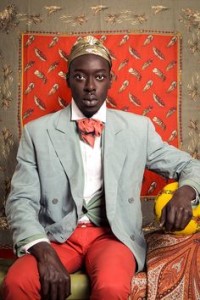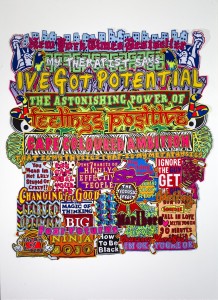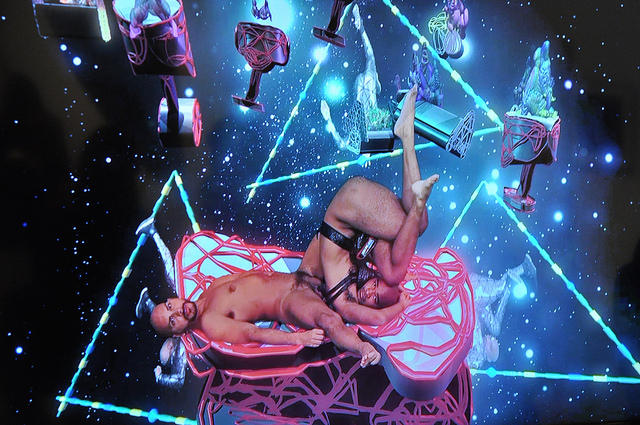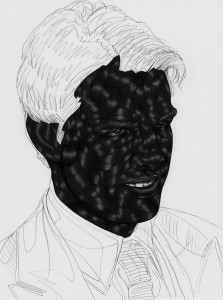
And although ‘Young, Gifted and Black’ remains undoubtedly progressive and beautiful even, it seems apt to recall that white supremacy doesn’t retreat from violence by uncovering its ignorance or even jumpstarting its conscience by colorful cultural promptings. Maybe, this time, we need to stop seeking refuge in an anti-black world and sing about the revolution that seeks to end it, as Nina did. Perhaps that is where it really is at.
Athi Mongezeleli Joja on the exhibition the American artist Hank Willis Thomas curated in Johannesburg.
Omar Victor Diop, Omar Ibn Said, 2015.
Young, Gifted and Black
Curated by Hank Willis Thomas
Frantz Fanon begins his famous chapter on “the fact of blackness” by telling us that when he entered “the world”, filled with all the enthusiasm of his youth, it singled him out as “an object in the midst of other objects.” That is to say a property of others, subject to their will. Fanon’s presence drowned into a series of defects, stereotypes and impossibilities. Such that, being black in the world was a fundamental corroboration of lack – a paradox of being without life and its things. In her classic 1969 song, ‘To Be Young, Gifted and Black’, Nina Simone grappled with this ideological paradox of a rumored life. In many ways, it was a song whose fancy was to subvert this imposition and recuperate life where death abounds.
Now, more than forty years on, conceptual artist Hank Willis Thomas has turned for inspiration to this classic in the midst of all the thanatotic skepticism that veils black bodies with valor and speed. ‘Young, Gifted and Black’, a show mounted at the Goodman Gallery in Johannesburg, is a curatorial piece that wills an agency of will-less agents. Such is blackness, the rubble that lives beneath the surface of the world, as it were its foundation and engine.
According to the show’s write up, it follows Nina’s call to “pay homage to and elevate the beauty, potential and actuality of lives raised out of struggle, lives which blossom in radiant and sometimes peculiar ways against all odds.” Though such moments cannot go unnoticed, we must also note the perfunctory inclination to turn defeat into celebratory stories. Well sometimes, Nina’s poetic call to the youth to seize the world runs the risk of being more of an injunction to busk in ludicrous bliss, a naïve self imposition to simulate life in the cemetery.
But if we rely on Ronald Barthes thesis, which insists that artistic pleasure doesn’t necessarily reside in literal depictions of “joy” but in the object’s revelatory and lyrical potential, we might find alternate ways to read the show.
Jody Paulsen, I’ve got potential, 2015.
Positioned at the entrance Jody Paulsen’s felt material piece appropriately and ironically titled ‘I’ve Got Potential’ receives us with a colorful optimism, childish seriousness and the playful joy of youth. Composed of differently colored layers of felt mats cut and cleverly impressed into patches of texts, Paulsen’s piece bends the material’s gaiety and forces it to a new context. From the garishly attractive works by Paulsen, the eye relents to the kaleidoscopic madness of Shanique Smith’s ‘Bale Variant’, Derrick Adams’ mixed media works, Ebony Patterson’s ‘Lily, Incarnation’, Omar Victor Diop’s portraits of black intellectuals to Jacolby Satterwhite’s ‘Reifying Desire 6’ video and so forth. This audaciously playful palette dominates the show, giving a light touch to the often-uninviting aura of the gallery. Somewhere between flamboyance, social commentary and historical memory “is where it’s at” as Nina would have it.
Reifying Desire 6, 2014.
Zoe Buckman, he came twice, 2014.
Similarly in Zoe Buckman’s ‘Every Curve’ series of suspended vintage lingerie, on which texts are lyrically embroidered on, a restrained palette lures us in. Though politically charged, Buckman’s garments are replete with a latent sense of beguiling intimacy in ways that might remind us of Audre Lorde’s notes on erotica. Here lingerie isn’t just a silent seductive undergarment, but talkative and even critical cultural item. Kiluanji Kai ‘Henda’s Peredosa’ enjoins us also to issues of sexuality and colonial exoticism, questioning how discourses on otherness are predicated on fabrication, ignorance and greed.
Toyin Ojih Odutola, The treatment 6, 2015.
While in Toyin Ojih Odutola’s ‘The Treatment’ portrait series of ink drawings there’s a retreat in the grandiosity, it also reverts us to color, but this time as a political tool experienced at the level of the body. As if switching roles with “white racism”, faces of figures resembling white folk have their identities erased. This reversal carries through in Hank Willis Thomas’ ‘Le Blanc Imite le Noir’, a new media work of text, which also switches to ‘Le Noir Imite Le Blanc’. However things are neither as easily reversible nor reciprocal as the above work seem to flatten them. Such relativistic assumptions tend to make racism mere cultural prejudice that can be switched at will, as opposed to structural subjection with historical permanence. Perhaps it is with Titus Kaphar’s painting, ‘George Washington’s Chef’, which depicts a portrait of Washington’s black cook, Hercules, with an erased face that helps me dramatizes my point. That is, the problem of color is analogous to black subjection. But again, Kaphar’s featureless face is merely a theatrical emphasis here. Essentially black erasure denotes an experience of a blackened body like the maid in Manet’s Olympia, whose humanity is irrelevant and appearance inconsequential.
Titus Kaphar, George Washington’s Chef, 2015.
Young, Gifted and Black might be seductive and admittedly an audacious gesture, but it’s not easy to discern what really motivates Thomas’ show of black visual artists under the banner of “young, gifted and black”. At times it is engaging and at others, it feels like an anthropological expose of young gifted things. But sometimes it is also just an exhausting thing to constantly prove one’s existence and capability to the world. As Fanon once said apropos blues, such: “restores racism.” And although Young, Gifted and Black remains undoubtedly progressive and beautiful even, it seems apt to recall that white supremacy doesn’t retreat from violence by uncovering its ignorance or even jumpstarting its conscience by colorful cultural promptings. Maybe, this time, we need to stop seeking refuge in an anti-black world and sing about the revolution that seeks to end it, as Nina did. Perhaps that is where it really is at.





